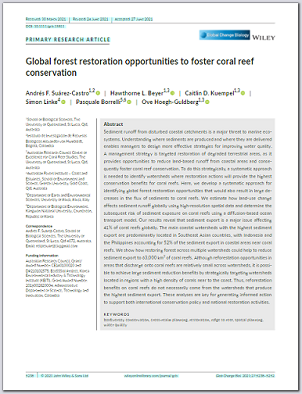
Sediment runoff from disturbed coastal catchments is a major threat to marine ecosystems. Understanding where sediments are produced and where they are delivered enables managers to design more effective strategies for improving water quality. A management strategy is targeted restoration of degraded terrestrial areas, as it provides opportunities to reduce land-based runoff from coastal areas and consequently foster coral reef conservation. To do this strategically, a systematic approach is needed to identify watersheds where restoration actions will provide the highest conservation benefits for coral reefs. Here, we develop a systematic approach for identifying global forest restoration opportunities that would also result in large decreases in the flux of sediments to coral reefs. We estimate how land-use change affects sediment runoff globally using high-resolution spatial data and determine the subsequent risk of sediment exposure on coral reefs using a diffusion-based ocean transport model. Our results reveal that sediment export is a major issue affecting 41% of coral reefs globally. The main coastal watersheds with the highest sediment export are predominantly located in Southeast Asian countries, with Indonesia and the Philippines accounting for 52% of the sediment export in coastal areas near coral reefs. We show how restoring forest across multiple watersheds could help to reduce sediment export to 63,000 km2 of coral reefs. Although reforestation opportunities in areas that discharge onto coral reefs are relatively small across watersheds, it is possible to achieve large sediment reduction benefits by strategically targeting watersheds located in regions with a high density of corals near to the coast. Thus, reforestation benefits on coral reefs do not necessarily come from the watersheds that produce the highest sediment export. These analyses are key for generating informed action to support both international conservation policy and national restoration activities.












